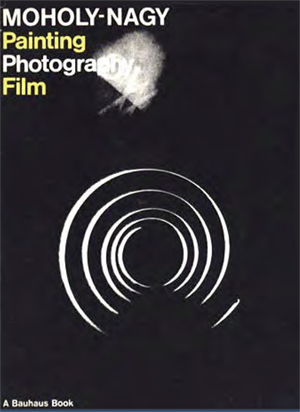bauhausbuch 08
l. moholy-nagy
malerei photographie
film
1925
schriftleitung
walter gropius
l. moholy nagy
New typographers like Moholy had special problems with the »typographic rigidity«. Letterpress printing simply ties the designer down to use an orthogonal grid, or the typesetting caused enormous costs. In addition, each image that used the typeface did cost a second printing process – unless the image already contained the typeface. »Typofotos« such as the photogram »Broom« or the advertisement from »Vanity Fair«, reproduced in Volume 8, offer such a solution.
For the cover of this book, he accepted the overprinting of the image, but looked for a way to integrate the inscription into the pictorial space.
Therefore he asked the printer for the following proofs: vermilion lettering on a black photogram and ultramarine blue lettering on a brown photogram. The result: the font still formed a separate layer. He then had the colors changed: The words "painting" and »film« were to become white, while the rest of the writing remained red.
»But with this proof, I see that the two words are much more prominent than I intended.« So at the end he assigned the protruding white to the other two words, which – perforated by spatulas – optically produce a broken white that strikes far less. All lines thus leave their separate layers. The words, now deprived of their common ground, become part of a completely artificial space that continues in the photogram.
Ute Brüning - Lecture for the Goethe-Institut / Forening for Boghaandværk, Copenhagen, 2002/ 2018. Further information in German: Ute Brüning. Bauhaus books. Graphical synthesis - synthetic graphics.
PDF Download 138 MB
Source: Bibliothèque Kandinsky
SKETCH FOR A FILM
ALSO TYPOPHOTO
L. MOHOLY-NAGY
”
The manuscript sketch Dynamic of the Metropolis was written in the year 1921-1922. I hoped to carry it out with my friend Carl Koch, who gave me many ideas for this work. So far, unfortunately, we have not managed to do so; his Film Institute had no money for it. The larger companies like UFA were at that time unwilling to risk enterprises which appeared bizarre; other film-people could »find no action in it despite the good idea« and so declined to film it.
Some years have passed since then and everyone today has some idea of what is meant by the proposition - revolutionary in its effect in the early days - of the FILMIC, that is, of the film which proceeds from the potentialities of the camera and the dynamics of motion. Suchfilms have been shown in 1924 in Vienna by Fernand Leger at the International Festival of Theatre and Music and in Paris - as an entr'acte in the Swedish Ballet - by Francis Picabia.
Some American comedy films contain similar filmic moments and we may say that by now all good film-directors are concerned to establish the optical effect proper to the film alone and that the films of today are constructed to a much greater extent upon tempo of movement and the contrast of light and shade and the various optical views than on theatrical action. This type of film is not concerned with the actor's star-performance, nor indeed with the actor's performance at all. (…)
DYNAMIC OF THE METROPOLIS
The intention of the film 'Dynamic of the Metropolis' is not to teach, nor to moralize, nor to tell a story; its effect is meant to be visual, purely visual. The elements of the visual have not in this film an absolute logical connection with one another; their photographic, visual relationships, nevertheless, make them knit together into a vital association of events in space and time and bring the viewer actively into the dynamic of the city.
No work (of art) can be explained by the sequence of its elements. The totality of the sequence, the sure interaction of the smallest parts upon one another and upon the whole are the imponderables of the effect. Thus I can explain only some of the elements of this film, so that at least people will not stumble over cinematically obvious happenings.
Aim of the film: to take advantage of the camera, to give it its own optical action, optical arrangement of tempo - instead of literary, theatrical action: dynamic of the optical. Much movement, some heightened to the point of brutality.
Individual parts which do not 'logically' belong together are combined either optically, e.g., by interpenetration or by placing the individual images in horizontal or vertical strips (so as to make them similar to one another), by a diaphragm (e.g., by shutting off one image with an iris-diaphragm and bringing on the next from a similar iris-diaphragm) or by making otherwise different objects move in unison, or by associative connections.
BAUHAUS BOOK 08
L.MOHOLY-NAGY
PAINTING
PHOTOGRAPHY
FILM
1925
with a note by hans. m. wingler postscript by otto selzer
tr: janet seligman
1966 florian kupferberg publishers
lund humphries london

PDF Download 65 MB
Source: monoskop.org
Balconies. The optical truth of the perspectival construction. Photo Moholy-Nagy
Camera-less photograph. Constrasting relationsships between black and white with the finest transitions of grey. Photo Moholy-Nagy
Camera-less photograph Photogram: Moholy-Nagy
Pneumatik (Tire), 1923–1924. Collage. ©The Moholy-Nagy Foundation
Design for the title-page of the journal Broom New York, 1922. Typophoto: Moholy-Nagy
Advertising poster „PNEUMATIC“. Photoplastic: Moholy-Nagy
Photogram, 1923–1925. Gelatin silver photogram © The Moholy-Nagy Foundation, Inc.
Cover design for Painting Photography and Film, Bauhaus Bücher (Bauhaus Books), 1925
Photogram, 1923–1925. Gelatin silver photogram. ©The Moholy-Nagy Foundation, Inc.
Photogram, 1922. Gelatin silver photogram. ©The Moholy-Nagy Foundation
Pages from Broom 4, 4 (Mar. 1923), 1923. ©The Moholy-Nagy Foundation
Photographed reflection in a convex mirror. Foto: Muche / Bauhaus